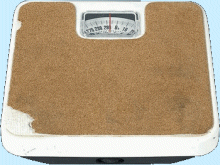The 7 (Honest) Facts You Should Know About
Losing Thigh Fat, Gut Fat, and
Fat in Other "Problem" Areas
© 2013 Health Realizations, Inc.
That stubborn fat around hips, buttocks and thighs for women, and the belly and side "love handles" for men, is every dieter's biggest adversary. It is the last 10 pounds to go, and it is always the hardest to lose.
There are several theories why that stubborn fat is stored in different places for men and women. Some say it's genetic. Your body stores fat where there are fat cells, and for most of us they concentrate on the upper and lower midsection. Exactly where the fat goes may depend on the lipoprotein lipase, which is an enzyme necessary for fat storage.
Women have more of this enzyme in the thighs and buttocks while men have higher concentrations in the abdomen.
|

Contrary to popular belief, doing sit-ups will not help you lose abdominal fat.
|
It could also be related to hormone levels. Women with more estrogen tend to have a smaller waist to hip ratio, for instance. And postmenopausal women (who have low levels of estrogen) may feel like they are "spreading out" even as their weight remains the same.
Others say that fat storage is all about evolution. Women store fat around their buttocks, hips and thighs because this makes them more desirable to a mate. Says Mike Adams, the Health Ranger:
"In this way, the fat is stored in predetermined locations on your body for much the same reason that a male peacock has brightly colored feathers--it's part of the mating game, so to speak. Exaggeration of physical traits is a common evolutionary strategy for mate attraction in primates, including humans. And body fat can be used cosmetically to pursue this strategy."
How to Get Rid of Stubborn Gut, Butt, Thigh, Hip Fat
There is one common misconception when it comes to removing hard-to-lose fat, and that's the idea that focusing your efforts on one area of your body will help. Men, for instance, may be tempted to do sit-up after sit-up trying to lose their spare tire. And while this may indeed firm up the midsection, it will not make the fat there go away any faster than it will the fat on your big toe.
|

A whole-body approach of healthy eating and exercise will make the stubborn fat go away
|
"There is no food, no exercise, and no herb that will cause your body to remove fat in one place versus another," says Adams.
To remove fat, no matter where it may be, you must follow the basic rule of weight loss: burn more calories than you consume.
As the American Academy of Family Physicians says, "To lose weight, you have to cut down on the number of calories you consume and start burning more calories each day."
For women, this means eating about 1,200-1,500 calories per day. Most men should eat 1,500-1,800 calories a day to lose weight, according to the American Heart Association.
There is good news and there is bad news to knowing this approach. The bad news is that that stubborn fat on your buttocks, thighs and hips if you're a woman, and around your abdomen if you're a man, will almost assuredly be the last to go. Your body is preconditioned to keep fat in those areas, so it won't start burning it up until all the other excess fat is gone.
The good news is that this approach is completely doable and does work. Here are seven tips to get you started.
-
Cut out excess "empty" calories like those from soda, candy, cookies, sweetened drinks and chips first.
-
Exercise regularly (include aerobic exercise like jogging, biking or swimming with strength training).
-
Don't focus your workouts on a specific body area (like abs or legs). Use a whole-body approach instead.
-
Avoid eating too many processed carbs (white sugar and white flour, etc.). These extra carbohydrates are easily converted into fat.
-
Don't get caught up in yo-yo dieting. The more you lose weight and regain it again, the worse it is for your health and the harder it will become to get rid of fat.
-
Limit your alcohol intake. It's high in calories and excessive drinking will leave you little energy to stick with your exercise routine.
-
Bake, grill, steam or broil food instead of frying it (fewer calories and better for health and energy).
If Your Weight is an Issue, This Is (By Far) the Most Important Secret You Should Know
The grapefruit diet, the cabbage soup diet, the apple cider vinegar diet, the high-carb low-fat diet, the low-carb high-fat diet ... no matter how many fad diets you've tried it is likely you have noticed they have one thing in common: they don't work. At least not in the long run.
And that is because, as we all inherently know but like to forget (or choose to ignore), losing weight is really more about simple mathematics than it is about concocting massive quantities of cabbage soup or grapefruit. Eat more calories than your body burns off, and you'll start to gain weight. The equation is really just that simple: Too many calories + not enough activity = excess pounds.
|
.aspx?width=220&height=208)
Losing weight shouldn't be tedious. Throw away the measuring tape and pick up some healthy foods!
|
As the American Academy of Family Physicians puts it, "To lose weight, you have to cut down on the number of calories you consume and start burning more calories each day."
How to Eat to Lose Weight
This is key because no one will stick to a diet that leaves them feeling hungry -- nor should they. Ironically, in order to lose weight, it's essential to eat enough. The trick is to eat the right foods that will help you feel satisfied without pushing your calorie meter too high.
Keep in mind that to lose one pound of fat, you need to burn 3,500 more calories than you take in. So, the American Heart Association says that to lose weight:
-
Most women should eat about 1,200-1,500 calories per day.
-
Most men should eat 1,500-1,800 calories a day.
You don't have to count every calorie (counting calories is tedious, and eating healthy should not be). Just eat close to the ideal numbers above. Some people feel best eating three meals a day and one snack, while others feel more satisfied eating five or six smaller meals. Experiment to find out what feels best to you.
Another important tip: Always eat breakfast. "Eating breakfast can help many people manage their weight and may help curb binge eating," says the American Heart Association.
What to Eat to Lose Weight
|

Don't get discouraged if your weight loss is gradual. A loss of one or two pounds a week is considered healthy.
|
Picking healthy foods is not only important from a weight loss standpoint. Getting your calories from foods packed with nutrients (things like fruits, vegetables, whole grains, lean meats, fish and dairy) will help you to prevent disease, increase your energy levels and keep your organs and other body systems functioning at their peak levels to fully optimize weight loss.
"You want to stay within your daily calorie needs, especially if you're trying to lose weight," says Eric Hentges, Ph.D., director of the USDA Center for Nutrition Policy and Promotion. "But you also want to get the most nutrients out of the calories, which means picking nutritionally rich foods."
In fact, changing your eating habits now can help you to lose weight while lowering your risk of future illness.
Says Walter Willet, M.D., chairman of the nutrition department at the Harvard School of Public Health, "We know that when people have health problems or their friends become ill, these are strong motivators of change. The more serious the health condition, the more serious the change. We'd rather people made changes early and prevent health problems in the first place."
As you start to transition to healthier eating, follow these tips from the U.S. Food and Drug Administration:
-
Most of your fats should come from polyunsaturated and monounsaturated fatty acids, in foods like fish, nuts and olive oil.
-
Cut down on calories by trimming the fat off meat and taking the skin off chicken.
-
Bake, grill, steam or broil food instead of frying it.
-
Eat a variety of whole fruit, rather than fruit juice. "The whole fruit has more fiber, it's more filling, and it's naturally sweet," says Marilyn Tanner, a pediatric dietitian at the Washington University School of Medicine in St. Louis.
-
Eat a wide variety of vegetables, including dark greens. Along with the many outstanding nutrients, the fiber in vegetables (and whole fruits) will help you feel full.
-
When choosing grains, pick items that have whole grains listed as the first ingredient on the label.
-
Limit added sugars in your diet in foods like soft drinks, candy, cake, cookies, pies and fruit drinks.
How to Exercise Effectively
|

For a 200-pound person, swimming burns over 350 calories an hour.
|
You should strive to exercise for 30 to 60 minutes on most days of the week. Vary your routine to include aerobic exercises (jogging, swimming, kickboxing) and light weight training. The aerobic exercises raise your heart rate, which helps burn calories, while weight training adds muscles mass to your body. Muscle burns calories faster than fat, so the more muscle you have, the more calories you'll burn.
If you haven't been physically active in awhile, you'll need to start slowly and work your way up to longer, more intense workout. A great way to start moving is by taking a walk outside.
Looking for the most "bang for your exercise buck"? The chart below, from the American Heart Association, lists some popular exercises, along with the number of calories you'll burn after doing the activity for one hour (depending on your weight).
| Activity |
100 lb |
150 lb |
200 lb |
| Bicycling, 6 mph |
160 |
240 |
312 |
| Bicycling, 12 mph |
270 |
410 |
534 |
| Jogging, 7 mph |
610 |
920 |
1,230 |
| Jumping rope |
500 |
750 |
1,000 |
| Running 5.5 mph |
440 |
660 |
962 |
| Running, 10 mph |
850 |
1,280 |
1,664 |
| Swimming, 25 yds/min |
185 |
275 |
358 |
| Swimming, 50 yds/min |
325 |
500 |
650 |
| Tennis singles |
265 |
400 |
535 |
| Walking, 2 mph |
160 |
240 |
312 |
| Walking, 3 mph |
210 |
320 |
416 |
| Walking, 4.5 mph |
295 |
440 |
572 |
Chart Source: http://www.americanheart.org/presenter.jhtml?identifier=756
You can also add more activity into your day by making some small adjustments, including:
-
Parking at the farthest end of the parking lot.
-
Taking the stairs instead of the elevator.
-
Going for a walk on your lunch break.
-
Walking to work, school, to get groceries, etc.
-
Playing with your kids and/or pet.
-
Doing sit-ups or jogging on a treadmill while watching TV.
Don't Give Up!
By making even small changes in your diet and activity level, you'll notice yourself feeling and looking better. But don't get discouraged if your weight loss doesn't happen overnight. A loss of one to two pounds per week is considered a healthy weight loss. And, according to the American Heart Association, people who lose weight gradually are more likely to keep it off.
Sources
News Target: The Truth About Losing Abdominal Body Fat
The Nutrition Notebook: Adipose Tissue
Naturodoc: The Final Frontier of Dieting
U.S. FDA Healthier Eating
American Heart Association
American Academy of Family Physicians
